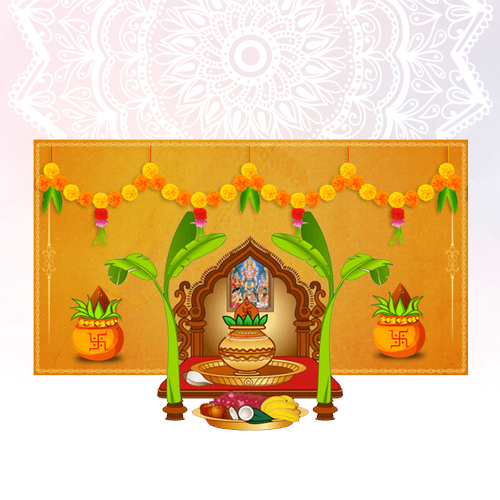
Satyanarayan katha
Satyanarayan Katha: Meaning and Significance
Satyanarayan Katha is a Hindu ritual dedicated to Lord Vishnu, performed to seek blessings for prosperity, peace, and happiness. It involves the recitation of the Satyanarayan Katha (story) and is often conducted on special occasions such as weddings, housewarming ceremonies, and during full moon (Purnima) days. This pooja is a way to express gratitude to Lord Vishnu and to invoke his blessings for a fulfilling life.
Steps and Procedure for Satyanarayan Katha
-
Preparation:
- Choosing an Auspicious Date: Consult a priest or astrologer to determine an auspicious date for the pooja.
- Cleansing and Decoration: Clean the house and pooja area, decorate with flowers, rangoli, and lamps.
- Gathering Materials: Collect items such as flowers, fruits, sweets, betel leaves, betel nuts, turmeric, sandalwood paste, incense sticks, ghee, and a photo or idol of Lord Vishnu.
-
Setting up the Altar:
- Placing the Deity: Place the idol or picture of Lord Vishnu (Satyanarayan) on a clean and decorated altar.
- Arranging Pooja Items: Place all pooja items neatly around the altar.
-
Invocation (Avahanam):
- Ganesh Pooja: Begin by invoking Lord Ganesha to remove obstacles.
- Kalash Sthapana: Place a kalash (pot filled with water) with a coconut on top, symbolizing the presence of the deity.
-
Sankalp (Resolution):
- Taking the Sankalp: The person performing the pooja takes a vow (sankalp) stating the purpose of the pooja and seeking blessings.
-
Main Pooja:
- Ganesh Pooja: Worship Lord Ganesha by offering flowers, turmeric, sandalwood paste, and prasad.
- Navagraha Pooja: Worship the nine planets (Navagrahas) to seek their blessings.
- Worship of Lord Satyanarayan:
- Chanting Mantras: Chant specific mantras dedicated to Lord Vishnu.
- Offering Items: Offer flowers, fruits, sweets, turmeric, sandalwood paste, rice, and water to the deity while chanting the mantras.
-
Satyanarayan Katha:
- Recitation: The priest or the devotee reads the Satyanarayan Katha, which includes five chapters detailing various stories and the significance of performing this pooja.
- Offering Prasad: Offer prasad, which typically includes a special preparation made of wheat flour, sugar, and ghee (Panchamrit).
-
Havan (Fire Ritual):
- Setting up the Havan Kund: Prepare the havan kund (sacrificial fire pit) and light the fire.
- Offering Ahuti: Offer ghee, rice, and special herbs into the fire while chanting specific Vedic mantras.
-
Arati (Waving of Lamps):
- Performing Arati: Light the lamp and perform arati by waving it in front of the deity in a circular motion while singing devotional songs.
-
Prasad Distribution:
- Offering Food: Offer cooked food, fruits, and sweets to Lord Vishnu.
- Distributing Prasad: After the pooja, distribute the prasad among the family members and guests.
Benefits of Satyanarayan Katha
- Divine Blessings: It brings divine blessings for a happy, healthy, and prosperous life.
- Gratitude: The pooja is a way to express gratitude for the past year’s blessings.
- Spiritual Growth: Regular practice of such rituals enhances spiritual growth and devotion.
- Health and Well-being: The pooja promotes physical and mental well-being.
- Family Unity: Celebrating the pooja with family members fosters unity and togetherness.
- Mitigates Negative Influences: Helps in mitigating negative influences and obstacles in life.
- Prosperity and Success: Invokes blessings for material prosperity and success in personal and professional endeavors.
Satyanarayan Katha is a powerful and auspicious ritual that helps devotees seek the blessings of Lord Vishnu for a prosperous and harmonious life. By performing this pooja with devotion and sincerity, devotees express their gratitude and invoke divine blessings for themselves and their families.
 Add Temple
Add Temple